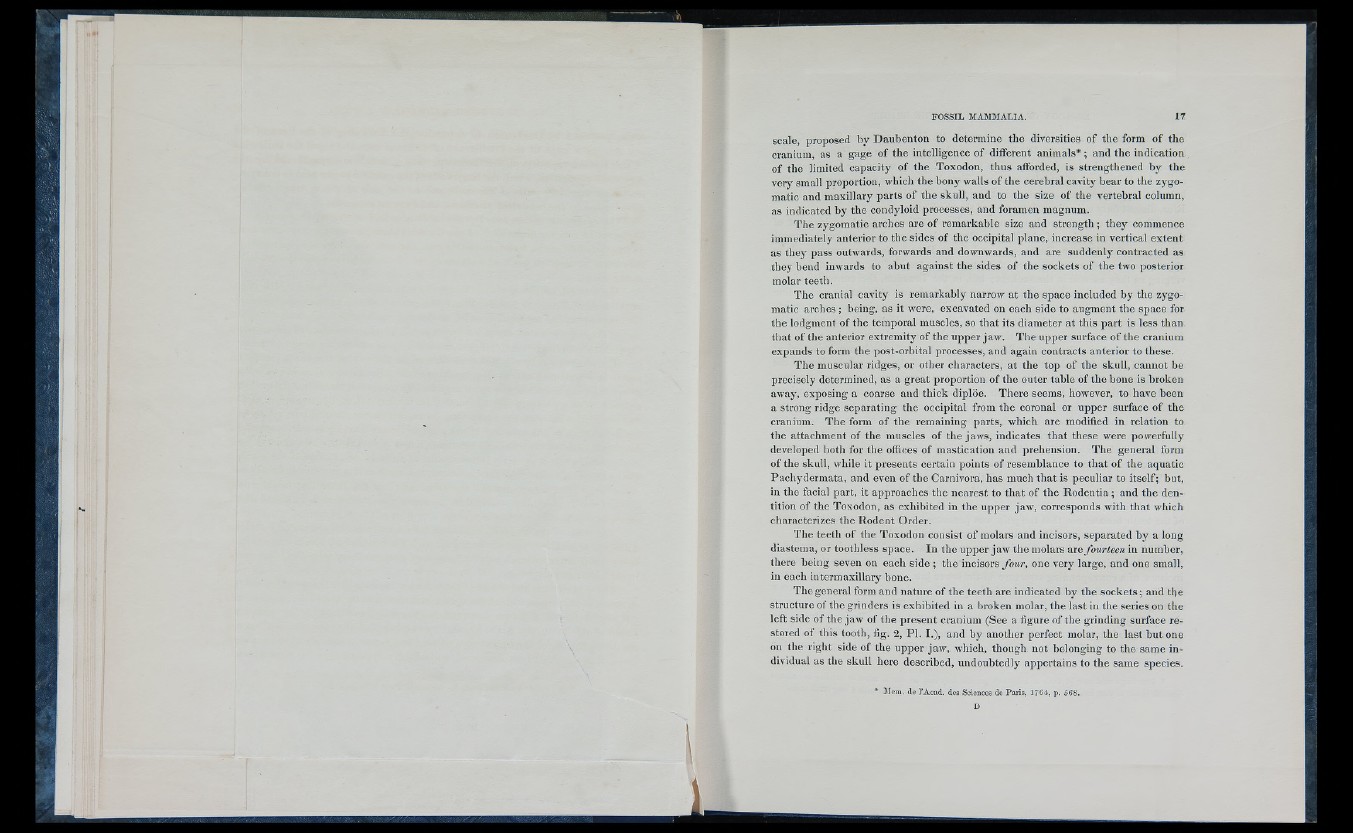
scale, proposed by Daubenton to determine the diversities o f the form o f the
cranium, as a gage o f the intelligence o f different a n im a ls* ; and the indication
o f the limited capacity o f the Toxodon, thus afforded, is strengthened b y the
very small proportion, which the bony walls o f the cerebral cavity bear to the zy g o matic
and maxillary parts o f the skull, and to the size o f the vertebral column,
as indicated by the condyloid processes, and foramen magnum.
The zygomatic arches are o f remarkable size and str en g th ; they commence
immediately anterior to the sides o f the occipital plane, increase in vertical ex ten t
as they pass outwards, forwards and downwards, and are suddenly contracted as
they bend inwards to abut against the sides o f the so ckets o f the two posterior
molar teeth.
Th e cranial cavity is remarkably narrow at the space included by the zygomatic
a r ch e s; being, as it were, excavated on each side to augment the space for
the lodgment o f the temporal muscles, so that its diameter at this part is le ss than
that o f the anterior extremity o f the upper jaw. The upper surface o f the cranium
expands to form the post-orbital processes, and again contracts anterior to these.
The muscular ridges, or other characters, at the top o f the skull, cannot be
precisely determined, as a great proportion o f the outer table o f the bone is broken
away, exposing a coarse and thick diploe. There seems, however, to have been
a strong ridge separating the occipital from the coronal or upper surface o f the
cranium. The form o f the remaining parts, which are modified in relation to
the attachment o f the muscles o f the jaws, indicates that these were powerfully
developed both for the offices o f mastication and prehension. T h e general form
o f the skull, while it presents certain points o f resemblance to that o f the aquatic
Pachydermata, and even o f the Carnivora, has much that is peculiar to itself; but,
in the facial part, it approaches the nearest to that o f the R odentia ; and the dentition
o f the Toxodon, as exhibited in the upper jaw, corresponds with that which
characterizes the Rodent Order.
Th e teeth o f the Toxodon consist o f molars and incisors, separated b y a long
diastema, or toothless spac e. In the upper jaw the molars are fourteen in number,
there being seven on each sid e ; the incisors fo u r, one very large, and one small,
in each intermaxillary bone.
The general form and nature o f the teeth are indicated by the s o ck e ts ; and tfie
structure of the grinders is exhibited in a broken molar, the last in the series on the
le ft side o f the jaw o f the present cranium (See a figure o f the grinding surface restored
o f this tooth, fig. 2, PI. I.), and by another perfect molar, the last but one
on the right side o f the upper jaw, which, though not belonging to the same in dividual
as the skull here described, undoubtedly appertains to the same spe cie s.
* Mem. de I’Acad. dcs Sciences do Paris, 1764, p. 568.